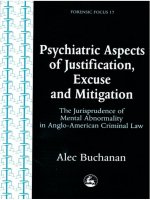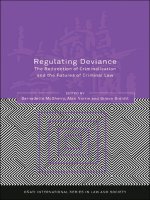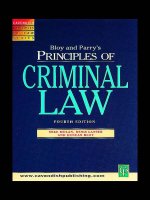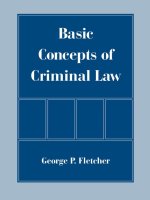BASIC CONCEPTS OF CRIMINAL LAW pot
Bạn đang xem bản rút gọn của tài liệu. Xem và tải ngay bản đầy đủ của tài liệu tại đây (13.16 MB, 236 trang )
BASIC
CONCEPTS
OF
CRIMINAL
LAW
This page intentionally left blank
BASIC
CONCEPTS
OF
CRIMINAL
LAW
George
P.
Fletcher
New
York Oxford
OXFORD UNIVERSITY PRESS
1998
Oxford
University
Press
Oxford
New
York
Athens Auckland Bangkok Bogota Bombay
Buenos Aires Calcutta Cape Town
Dar es
Salaam
Delhi Florence Hong Kong Istanbul Karachi
Kuala
Lumpur Madras Madrid Melbourne
Mexico City Nairobi Paris Singapore
Taipei
Tokyo Toronto Warsaw
and
associated companies
in
Berlin Ibadan
Copyright
©
1998
by
George
P.
Fletcher
Published
by
Oxford University Press, Inc.,
198
Madison Avenue,
New
York,
New
York
10016
Oxford
is a
registered trademark
of
Oxford
University Press
All
rights reserved.
No
part
of
this publication
may be
reproduced,
stored
in a
retrieval system,
or
transmitted,
in any
form
or by any
means,
electronic, mechanical, photocopying, recording,
or
otherwise,
without
the
prior permission
of
Oxford University Press.
Library
of
Congress Cataloging-in-Publication Data
Fletcher, George
P.
Basic
concepts
of
criminal
law /
George
P.
Fletcher
p. cm.
Includes bibliographical references
and
index.
ISBN
0-19-512170-8; 0-19-512171-6 (pbk.)
I.
Criminal law.
I.
Title.
K5015.4.F58
1998
345—DC21
97-33550
35798642
Printed
in the
United States
of
America
on
acid-free
paper
For
Deborah
and
Rebecca
Each Internationalist
in her Own
Way.
This page intentionally left blank
Acknowledgments
This
book began
not as a
scholarly enterprise
but as a
service
to the
text-hungry
law
faculties
of
Russia
and
other
post-Communist coun-
tries
in
Asia
and
Eastern Europe.
I
wanted
to
write
a
book
that
would
introduce Russian
law
students
to
Western ways
of
thinking about
criminal law. Indeed,
I
conceived
of
doing
a
series
of
books
for
Russian
law
students
on
basic concepts
of
law,
with
an
emphasis
on
jurispru-
dential
and
comparative issues.
The
Constitutional
and
Legislative Pol-
icy
Institute
in
Budapest,
then
headed
by
Stephen Holmes, thought
that
this
was a
good idea,
and we
entered into
a
contract
to
supply
the first
two
books
in the
series,
one on
criminal
law and one on
property.
Ugo
Mattei,
then
of the
Hastings
and
Trento, Italy,
law
faculties,
agreed
to
write
the
book
on
property.
Once
I
decided
to
organize
the
book around
the
twelve dichotomies
that
lie at the
foundation
of
criminal justice everywhere,
I
realized
that
the
approach
had
merit
as
well
for
American
and
Western European
students
of
law.
The
result
is a
series
of
books based, more
or
less,
on
the
modular text
that
lies
before
you.
In
each
foreign
edition,
a
local
commentator takes charge
of the
translation
and
adds material
on the
way
the
twelve universal distinctions discussed
in
this book
find ex-
pression
in the
local positive
law.
This
approach, which stresses
the
common philosophical dimen-
sions
of
criminal law, will soon
be
known
around
the
world.
The
Span-
ish
edition, prepared
by
Francisco Munoz Conde
of
Sevilla, Spain,
ap-
viii
Acknowledgments
peared
in
late 1997 under
the
title
Conceptos Basicos
de
Derecho
Penal.
The
publisher
is
Tirant
Lo
Blanch
in
Valencia.
The
Russian edition, with
extensive commentary
by
Anatolij Naumov
from
Moscow,
is
almost
ready
for
publication.
It
will
be
distributed, with
a
subsidy
from
George
Soros,
to all the law
faculties
in
Russia.
The
Italian edition, under
the
tutelage
of
Michele Papa
of
Modena, Italy,
is in
preparation. Other edi-
tions
are
under
negotiation.
The
full
collection
of
books based
on
this
modular text will provide
an
excellent library
of
comparative criminal
law.
The
process
of
working with collaborators
in
various countries
has
greatly
enriched
my
thinking about criminal law. Emboldened
by the
experimental nature
of
this project,
I
have ventured some
new
ideas
and
arguments that have advanced
my
understanding
of the
basic
structure
of
criminal law.
The
ideas presented here
go far
beyond
an
introductory
text.
I
hope
that
the
presentation
is
sufficiently straight-
forward
to be
easily grasped
by
beginners
as
well
as
scholars
of
criminal
law who are
used
to
more conventional modes
of
analysis.
Many
friends,
collaborators, assistants,
and
students have helped
me
keep
the
text direct
and
simple.
I am
indebted
to
Bruce Ackerman,
Russell
Christopher, Anthony
Dillof,
Albin
Eser,
Manfred
Gabriel, Kent
Greenawalt,
and
James Jacobs
for
thoughtful comments along
the
way.
I
hope that this
new way of
thinking about criminal
law
will stimulate
a
new
generation
of
students
and
scholars
to
explore
the
foundations
of
criminal justice.
Contents
Introduction,
3
1.
Substance versus Procedure,
7
The
Philosophical Problem: Substance versus Procedure,
10
The
Burden
of
Proof:
Half
a
Loaf,
14
The
Distinction
in
Context,
19
2.
Punishment
versus Treatment,
25
Two
Constitutional Perspectives: Motive versus Impact,
26
The
Purposes
of
Punishment,
30
The
Conceptual Analysis
of
Punishment,
33
Punishment:
Public
and
Private,
35
3.
Subject versus
Object,
43
The
Requirement
of
Human Action,
44
Acts
and
Omissions,
45
Commission
by
Omission,
47
Offenses
of
Failing
to
Act,
48
Alternative Approaches
to
Human Action,
50
Subject
and
Object
in
Criminal Procedure,
53
4.
Human Causes versus Natural Events,
59
The
Domain
of
Causation,
60
How
to
Approach Causation,
62
Problem
One:
Alternative
Sufficient
Causes,
63
Problem
Two:
Proximate Cause,
64
x
Contents
Problem Three: Omissions,
67
Causation
in
Ordinary Language,
69
Ideology
and
Causation,
70
5. The
Crime
versus
the
Offender,
74
The
Basics
of
Wrongdoing,
77
The
Basics
of
Attribution,
81
The
Operative Significance
of the
Distinction,
85
A
Problem
in the
Borderland: Putative
Self-Defense,
88
6.
Offenses
versus
Defenses,
93
Disputes about
the
Burden
of
Persuasion,
94
From
Defeasible
to
Comprehensive Rules,
97
Formal Reasoning,
97
The
Presumption
of
Innocence,
98
The
Moral Theory
of
Guilt,
99
The
Necessity
of the
Distinction
Between
Offense
and
Defense,
101
Can
a
Statutory
Justifiction
Be
Unlawful?,
106
7.
Intentions
versus
Negligence,
111
Accidents
and
Negligence,
113
Negligence: Objective
and
Subjective,
117
The
Structure
of
Culpable Intentions,
120
On
Motives,
124
The
Distinction Between
Intention
and
Negligence Revisited,
125
8.
Self-Defense
versus
Necessity,
130
Se
Defendendo
and
Necessity
as
Excuses,
130
Self-Defense
as a
Justification,
132
Necessity
or
Lesser Evils
as a
Justification,
138
Conflicts
Between
Self-Defense
and
Necessity,
143
9.
Relevant
versus
Irrelevant
Mistakes,
148
Irrelevant Mistakes,
149
Mistakes about Factual Elements
of the
Definition (Type One),
156
Mistakes about Legal Aspects
of the
Definition (Type Two),
156
Mistakes about Factual Elements
of
Justification (Type Three),
158
Putative Justification Negates
the
Required
Intent,
159
Strict
Liability:
The
Mistake
Is
Deemed Irrelevant,
160
Putative Justification
Is
Itself Justification,
161
Reasonable Mistake
as an
Excuse,
162
Mistakes about
the
Norms
of
Justifiction (Type Four),
163
Mistakes about
the
Factual Elements
of
Excuses (Type Five),
163
Mistakes about Excusing Norms
(Type
Six),
165
Summary
of
Mistakes: Relevant
and
Irrelevant,
166
10.
Attempts
versus
Completed
Offenses,
171
The
Search
for the
Primary
Offense,
172
The
Structure
of
Attempts: Impossibility,
176
The
Structure
of
Attempts: Abandonment,
181
Contents
xi
11.
Perpetration
versus Complicity,
188
The
Formal Equivalence
of
Perpetrators
and
Accomplices,
190
The
Differentiation
of
Perpetrators
from
Other Participants,
194
Two
Problematic Variations,
197
The
Expansion
of
Corporate Criminal Liability,
201
12.
Justice
versus
Legality,
206
The
Complexities
of
Legality,
207
The
Legal
Nature
of the
Twelve Basic Distinctions,
211
Implicit
Principles,
212
Index,
215
This page intentionally left blank
BASIC
CONCEPTS
OF
CRIMINAL
LAW
This page intentionally left blank
Introduction
Criminal
law has
become
codified
law. Everyplace
you go in the
West-
ern
world,
you
will
find a
criminal code that lays
out the
definitions
of
offenses
in the
code's
"special
part"
and
prescribes
general
principles
of
responsibility
in the
code's "general
part."
Germans
are
proud
of
their code enacted
in
1975. Americans cherish their Model Penal
Code,
which
has
provided
the
model
for the
recent
reform
of
criminal codes
in at
least
thirty-five
states.
The
French show
off
a new
1994 code,
as
do
the
Spanish
in
their 1995 innovation.
One of the first
items
of
busi-
ness
in the
post-Communist countries
of
Eastern Europe
is to
adopt
new
criminal codes
to
reflect
their
new
emphasis
on
human rights
and
the
just treatment
of
criminal suspects.
One
consequence
of
codification
is
that every country goes
its own
way.
Every
country
has
adopted
its own
conception
of
punishable
be-
havior,
its own
definitions
of
offenses,
its own
principles
for
determin-
ing
questions
of
self-defense,
necessity, insanity, negligence,
and
com-
plicity.
Criminal
law has
become state law, parochial law.
If
there
was
ever
much unity among
the
countries that succeeded
to the
domain
of
Roman law, there
is
none
now.
If
there
was
ever
a
common vocabulary
and set of
principles used
by
common
law
jurists, that commonality
has
long
since disintegrated.
In the
United States today,
it is
almost impos-
sible
to find two
states that have
the
same
law of
homicide. Every state
that
has
followed
the
Model Penal
Code
has
amended
and
adapted
the
model
code
to
meet
its own
local preferences.
The
republics
of the
for-
3
4
Basic
Concepts
of
Criminal
Law
mer
Soviet Union once
had
criminal codes that were,
as the
expressions
of
a
single centralized policy,
by and
large
the
same.
Now as
each
in-
dependent state
in the
region
drafts
its own
code,
we
await
a
cacophony
of
policies
and
principles. Soon
we
will have
as
many bodies
of
criminal
law as
there
are
distinct
flags
flying
over
sovereign
states.
Yet
as the
world
has in
fact
become more localized
in
criminal jus-
tice,
the
contrary aspiration
has
become stronger.
The
talk today
in the
European
Union
is of the
"Europeanization"
of
criminal law.
How
will
this
form
of
legal unification
be
possible
in the
light
of
intense
national
and
cultural
differences?
The
thesis
of
this book
is
that
there
is
already
much
greater unity
among diverse systems
of
criminal justice
than
we
commonly realize.
In
order
to
perceive this underlying unity,
we
must take
a
step back
from
the
details
and the
linguistic variations
of the
criminal codes.
The
unity that emerges
is not on the
surface
of
statutory rules
and
case
law
decisions
but in the
debates that recur
in
fact
in
every legal culture.
My
claim
is
that
a set of
twelve distinctions shapes
and
guides
the
contro-
versies
that inevitably break
out in
every system
of
criminal justice.
Whether
you
start
from
the
Model Penal
Code
or the
German Criminal
Code,
you
will inevitably
confront
disputes about these questions:
1.
What
is a
rule
of
substantive
(or
material) criminal law? What
is
a
rule
of
procedural
criminal law?
How do we
tell
the
difference?
2.
How do we
mark
the
boundaries
of
criminal
punishment
as op-
posed
to
other
coercive
sanctions,
such
as
deportation,
that
are
bur-
densome
but
non-criminal?
3.
What
is the
difference
between treating
the
suspect
as a
subject
and an
object,
both
in
terms
of the
criminal
act and the
unfolding
of
the
criminal trial?
4.
What
is the
difference
between
causing
harm
and
harm simply
occurring
as a
natural
event?
5.
What
is the
difference
between determining whether
a
crime,
or
wrongdoing,
has
occurred,
and
attributing
that
wrongdoing
to a
particular
offender,
that
is,
holding that person responsible
for the
crime?
6.
What
is the
distinction between
offenses
and
defenses?
7. How
should
we
distinguish between
intentional
and
negligent
crimes?
8. Why
should there
be
defenses
both
of
self-defense
and
necessity,
and
what
is the
distinction between
them?
9.
Why are
some mistakes
relevant
to
criminal liability
and
other
mistakes
irrelevant?
Introduction
5
10. How
should
we
distinguish between
completed
offenses
and at-
tempts
and
other inchoate
offenses?
11.
What
is the
difference
between someone
who is a
perpetrator
of
an
offense
and
someone
who is a
mere
accessory
to the
offense?
12.
In the
end,
how do we
distinguish between
legality
and
justice
in the
criminal process?
Some
of
these distinctions
may be
difficult
to
understand.
At
this
stage,
it is not
important
to
grasp
the
full
significance
of all of
them.
They
illustrate
the
underlying thesis
of
this book
that
a
basic
set of
distinctions generates
the
"deep
structure"
of all
systems
of
criminal
law. This
is, as it
were,
the
universal grammar
of
criminal law.
As
Noam
Chomsky
developed
a
universal grammar underlying
all the
particular
languages
of the
world, here,
in
these twelve distinctions lies
the
gram-
mar of
criminal law.
Understanding
the
deep, universal structure
of
criminal
law
pro-
vides
an
antidote
for the
positivist bias
of
recent decades.
It is
true
that
every
country
has a
criminal code,
but
these codes should
be
under-
stood
as
local answers
to the
universal questions
that
constitute
the
foundation
of
criminal law.
Different
countries
may
pose
different
res-
olutions
to the
same twelve underlying distinctions,
but
these resolu-
tions
on the
surface
of the law
should
not
obscure
the
unity that
un-
derlies
apparently diverse legal cultures.
If the
basic questions remain
constant,
then
legal cultures have more
in
common
than
they might
otherwise think.
There
are
many reasons
why
students
of
criminal
law
should wel-
come this approach. Mastering these twelve distinctions will
not
only
enable
the
student
to
understand
the
grammar
of the
legal culture
but
also
will
facilitate
appreciation
of the
unity
of the
world's legal systems.
Some
students might object.
I
imagine various types
of
students
and
their complaints:
Ms.
Patriot:
This student
is
simply interested
in her own
legal culture.
She
does
not
want
to
learn
the
underlying grammar
of
legal cultures
around
the
world.
To
her,
I
say:
Good,
perhaps
you
should
be
interested just
in
your
own
culture.
But
this method
of
learning distinctions will enable
you to
appre-
ciate
your local legislation
as
something more
than
just
the
arbi-
trary
rulings
of the
legislature.
In the
local rules that
you
learn,
you
will
find a
lasting message,
a
solution
to a
basic problem
that
runs
to the
foundation
of the
legal system.
You
have reason
to be
proud
of
your local law,
for it
represents
an
answer—and per-
haps
the
correct answer—to questions that criminal lawyers
and
judges
pose
all
over
the
world.
6
Basic
Concepts
of
Criminal
Law
Mr.
Efficient:
This student
is
concerned only about learning
the
local
law
as
quickly
and
efficiently
as
possible.
All
that counts
is
committing
the
rules
and
precedents
to
memory
so
that
he can
spout
them
back
on
examinations.
To
him,
I
say:
Good,
I
agree that this
is an
important value. Learn
the law
effi-
ciently. This method will
help
you do it. If you
master
the
basic
skeleton
of
twelve distinctions
and
understand what they
are
about,
the
data
of
your legal culture will provide
the
flesh
for
your local body
of
law.
It is
easier
to
learn twelve distinctions
and
their implications
than
to
memorize, say,
200
distinct rules.
Ms.
Professional:
This
hip
student wants only
to
know
how to
prepare
and to try
cases.
She
wants
to get
into court
as
soon
as
possible. What
is
the use of all
this theory? Teach
me how to win
cases,
she
insists.
To
her,
I
respond:
Good,
prepare
to win
cases.
But you
cannot prosecute
or
defend
unless
you
understand what
is at
stake
when
you
argue basic
questions
of
law. Anyone
can
look
up the
rules
in a
handbook.
What
you
need
to
excel
in
court
is an
understanding
of the
deeper
dynamic
of the
law,
the
hidden structure that influences
and
shapes
the
thinking
of
judges.
If you
delve into
the
deep dis-
tinctions that shape
the
contours
of the
law,
you
will have
an
edge
on the
pedestrian lawyers
who
tread
on the
surface
of the
law.
Mr.
Sport:
This
guy is
only interested
in who
wins
and who
loses.
Why
should
we
care about
the
ideas
of the
law,
when
these ideas might
not
impact
on
juries
or
judges
who
decide whether
the
defendant
is
guilty?
To
him,
I
reply:
Good,
winning
is
what
it is all
about.
But it is
important
to
know
what
the
prosecution
and the
defense
are
actually winning
and
losing. There
is
more
at
stake
in the
contests
of the law
than
just
the
fate
of a
single individual. When O.J. Simpson
is
found
not
guilty,
the
repercussions
are
felt
across
the
country.
The
conse-
quences
hit
those concerned about race, battered women, con-
trolling
the
police,
and the
reliability
of the
jury system.
In all im-
portant
cases,
there
is
more
at
stake
than
one
person's winning
or
losing. Tennis
may be
only about
the
player
who
wins;
the law
is
also about
the
ideas that prevail.
Maybe
these replies will
win
over
the
skeptics. Maybe not.
The
better
way to
prove
the
merit
of
this approach
to
criminal
law is to
immerse oneself
in it. It
should become obvious
as we
proceed that
mastering
the
deep structure
of the law
enables
one to
understand
the
significance
of
local details
and
variations.
1
Substance
versus
Procedure
When
you
look
at the law
from
a
distance,
you see a
maze
of
rules.
This
is the
maze that ensnared
the
accused Joseph
K. in
Kafka's
The
Trial
when
he
tried
to
determine
whether
he was
guilty
of a
crime.
If
you
look
at the
maze more
carefully,
you find
that
the
rules break
down into
two
general categories, rules
of
substance
and
rules
of
pro-
cedure.
The
substantive rules
define
the
crimes
that
are
punished
in
the
particular state
or
country.
If
Joseph
K. was
guilty
of a
crime,
that crime would have been defined
in the
substantive rules
of the
local
criminal law.
If
those rules
are
secret
or too
complicated
or too
vague
to
understand,
then
the
legal
system inhumanely drives people
to
anxiety about whether they
are
guilty
of a
transgression against
the
rules.
Being
guilty
is one
thing; being prosecuted
and
punished another.
Whether
one is
ever held liable
for a
particular
offense
depends
on the
rules
of
procedure. These rules determine
how the
state
enforces
the
criminal
law by
proving
the
occurrence
of
crime
and
convicting
and
punishing those responsible
for the
crime.
In
general terms,
we can say
that
the
substantive rules establish
"guilt
in
principle."
The
procedural rules determine
whether
individ-
uals
are
"guilty
in
fact."
Whether guilt
in
principle becomes guilt
in
fact
depends
on
several
factors—on
the
evidence available,
on the
rules
for
introducing
and
evaluating this evidence,
and on the
personalities
and
talents
of
those
charged
with
making
the
decision
of
guilt.
The
7
8
Basic
Concepts
of
Criminal
Law
agony
of
Joseph
K.
derives
not
only
from
the
inscrutable rules
of
sub-
stance
but
from
the
torture
of
undefined procedures.
The
rules
of
legal procedure allocate functions among
the
lawyers,
the
judge,
and the
jury
or the lay
people
who
assist
the
judge
in finding
the
facts
of the
cases. They also determine
the
scope
of
admissible
ev-
idence, prescribe provisions
for
appeal,
and
establish criteria
for re-
versing judgments
and
starting
all
over again. These rules determine
the way the
game
is
played.
And the
game
is
always played
the
same
way,
whether
in the
particular case
the
rules lead
to
what appears
to
be
a
just result
or
not.
In
real games
and
sports, curiously,
we
rarely
find
procedures
for
litigating
disputes.
The
substantive rules
of
card games, chess, baseball,
hockey,
and
other games determine
when
one
side scores
a
point, loses
a
piece,
or
commits
a
foul.
If
there
is a
dispute about
the
facts
to
which
the
rules apply (did
the
ball
hit on
this
or
that side
of the
line?),
the
rules
for
settling disputes
are
typically
no
more complicated
than
"the
umpire decides"
or
"each
side
calls
its own
fouls."
In
most areas outside
of
the
law,
we
make
do
with informal processes that depend
on the
good
faith
of all
concerned.
Games
assume
the
good
faith
of all
participants.
But the law as-
sumes rather that litigants
are
motivated
by
self-interest.
To
secure their
ends, they might well
act in bad
faith.
For
this reason,
the
procedures
for
settling disputes
are as
important
as the
rules
that
determine,
in
principle,
who
should
win and who
should lose.
We
may
understand
the
general points behind
the
distinction
be-
tween substance
and
procedure,
but do we
understand
how the
dis-
tinction works
in
practice?
Let us
consider
the
problem more deeply.
Our
reflections
on
establishing guilt under
the law are
summarized
in the
following syllogism:
Major:
Whoever intentionally kills another person
is
guilty
of
murder.
Minor:
On
January
1,
1996,
John
Jones intentionally
killed Bruce Barnes.
Conclusion:
John
Jones
is
guilty
of
murder.
This
is the
"syllogism
of
legal
guilt."
The
major
premise
is
defined
by
the
rules
of
substantive law.
The
minor premise
is a
matter
of
fact,
and
the
facts
are
established
by
following
the
procedures laid down
in
pro-
cedural rules, namely,
the
rules
for
conducting
a
fair
trial.
Note
there
is
also
a
process
or a
procedure
for
determining
the
major
premises.
The
rules
of
substantive
law are not
self-evident.
The
trial judge determines
what
these rules
are by
researching
the law in
the
books
or by
asking
for
briefs
from
the
lawyers
on
questions
of
law.
Surprisingly,
there
are no fixed
rules
for
fathoming
the
rules
of
sub-
Substance
versus Procedure
9
stantive law.
The
process
is
informal,
and
much depends
on how
par-
ticular
judges
like
to
work.
In a
system based
on
jury trial,
as in the
United States,
the
judge
expresses
the
major premises
of the law in his
instructions
to the
jury.
The
jury determines
the
factual
issues
in the
minor premises,
and
then,
when
the
system works properly,
the
jury applies
the law to the
facts,
the
major
premise
to the
minor. Jury instructions also contain proce-
dural
rules, such
as one
requiring
the
jury
to be
convinced beyond
a
reasonable doubt that
a
fact
relevant
to the
minor premise
is
true.
If
the
jury
has
doubts that
it
identifies
as
reasonable,
then
it may not
regard
the
fact
as
proven.
Most constitutions
of the
world
are
more concerned about proce-
dural rights
than
about rights
to a
substantive
law of a
certain sort.
The
Fifth
and
Sixth Amendments
to the
U.S. Constitution list
an
array
of
rights
(e.g.,
right
to
counsel,
jury trial)
that
are
designed
primarily
not
to
promote
the
efficiency
of the
trial
but to
protect
the
interests
of the
accused.
With regard
to
substantive law,
the
most common constitutional
provision today bespeaks
the
liberal principle that states must advise
their citizens
in
advance
of the
substantive rules
of
conduct which
might trigger criminal liability.
The
U.S. Constitution expressly prohib-
its
ex
post
facto
laws
[no
legislation
after
the
fact].
1
The
same rule
is
made explicit
in the
1949 German
Basic
Law and in
virtually
all
modern
constitutions.
2
This excludes
a
certain
set of
possible
major
premises,
namely, those rules
that
are
legislated
as
statutory
law
after
the
facts
in the
minor premise have occurred.
It
follows
that
the
date
of the
law's
enactment
is
critical
to
whether
the
major
premise
is
constitutionally
acceptable.
A
more complete version
of the
major premise
in the ex-
ample would read, therefore:
As
of
January
1,
1996 (the date mentioned
in the
minor prem-
ise),
it was the law of
this state
(or
country) that:
Whoever intentionally kills another person
is
guilty
of
murder.
Adding
one
complication invites
another.
Now
that
we
have tied down
the law to a
particular date
and
place,
we
must
add the
qualification
the
crime occurred
in the
place
(or
under other circumstances)
that
give
the
court
"competence"
over
the
alleged crime. Adding
the re-
quirement
of
judicial competence changes
both
the
major
and
minor
premises
of the
syllogism
of
legal guilt.
The
full
statement becomes:
Major:
As of
January
1,
1996,
it was the law of
this
state
(or
country)
that:
Whoever intentionally kills
an-
other person within
the
competence
of the
court
is
guilty
of
murder.
10
Basic
Concepts
of
Criminal
Law
Minor:
On
January
1,
1996,
John
Jones intentionally
killed
Bruce Barnes within
the
competence
of the
court.
Conclusion:
John
Jones
is
guilty
of
murder.
1.1 The
Philosophical Problem:
Substance
versus
Procedure
It
seems
as
though
we
have
a
good idea
of the
difference
between
substantive
rules
and
procedural rules.
In
many borderline
cases,
how-
ever, this distinction
is
hardly obvious. Take,
for
example,
the
statute
of
limitations, which prescribes
the
time limit within which
the
state
may
prosecute
a
particular crime. This looks like
a
procedural rule,
but
it
could
be
interpreted
as
substantive
by
redrafting
the
major premise.
Suppose
that
the
limitation period
for
murder
is
twenty years. Then
the
major
premise
of our
example might read:
As
of
January
1,
1996 (the date mentioned
in the
minor prem-
ise),
it was the law of
this jurisdiction
that:
Whoever
intentionally killed
another
person
on or
after
January
1,
1976
is
guilty
of
murder.
Note
that this formulation
shifts
the
tense
of the
major premise
from
the
present
to the
past.
The
prohibition
is
transformed
from
one
against murder
in the
abstract
to one
that exposes
the
offender
to
lia-
bility
for a
period
of
twenty years.
It is as
though
the
major premise
read:
if you
kill someone,
you are
guilty
of
murder
for
twenty years
and no
longer.
But
what
is
wrong with this formulation?
The
question,
I
suppose,
is
whether
we
desire
to
have
the
norms
of the
criminal
law
express
general moral principles
or
whether they should
define
the
conditions under which
the
state
may
deprive
an
individual
of his or
her
liberty.
If you
take
the
view that
the
criminal
law
should state moral
rules,
the
prohibition should
be
against murder
in
general;
if the
pur-
pose
is to
define
the
conditions
of
liability,
the
latter approach
is
pref-
erable.
It
turns out,
then,
that
in
borderline cases
the
distinction between
substance
and
procedure raises philosophical issues.
We
cannot
clarify
the
distinction without
a
theory both about
the
nature
of
substantive
law
and the
particular issue
we are
trying
to
classify,
in
this case,
the
statute
of
limitations.
Assessing
the
nature
of the
statute
of
limitations became
a
burning
political
issue
in
Germany
after
World
War II. The
question
was how
long
the
West German government would
be
able
to
prosecute con-
centration camp murders under their homicide statute, which carried
Substance
versus Procedure
11
a
prescriptive period,
a
statute
of
limitations,
of
twenty years.
The
initial
German position
was
that
the
twenty-year period began running
in
May
1945
when
the
Third Reich collapsed
and
prosecution became
politically
feasible.
When
the
statutory period
was
about
to run out in
May
1965,
the
Bundestag [Parliament]
of the
Federal Republic
ex-
tended
the
period
for ten
years.
Before
the
prescriptive limit took hold
in
1975,
the
legislature abolished
it
altogether. When alleged
war
crim-
inals were prosecuted
after
1965
or
after
1975, could they legitimately
claim
that they were being
subject
to an ex
post
facto
law, namely,
a
rule
on
prosecuting
homicide
that
was
enacted
after
they
committed
their
offenses?
There
is
something unsettling about prosecuting concentration
camp killers
on the
basis
of the
German homicide statutes
in
force
at
the
time. There
is no
doubt
that
if
they killed
innocent
inmates, they
violated
the
statute. They could claim
an
exception, perhaps
on the
basis
of
administrative regulations
or
military orders. Contemporary
German courts
reject
defenses
of
this sort
on the
ground that
the im-
plicit
instructions
to
kill
were themselves secret
and
therefore
unlaw-
ful.
3
What remains
is the
statute prohibiting homicide. There
is no
dif-
ference,
in the
view
of
German courts,
between
killing
someone
in a
1943 Berlin robbery
or
killing someone
in a
1943 Auschwitz
gas
cham-
ber.
The
legislature's extending
the
statute
of
limitations
differs
argua-
bly
from
the
courts' disregarding unjust orders
to
kill.
By
extending
the
prescriptive
period,
the
legislature changes
the
time period
in
which
the
alleged criminal
is
subject
to
liability. That requires
us to
answer
the
question whether
the
twenty-year prescriptive period enters
in the
definition
of the
crime
that
the
guards committed. There
are two in-
terpretations,
one
substantive,
one
procedural:
The
substantive
If you
intentionally kill
an
innocent
per-
interpretation: son,
you are
guilty
of
murder
for
twenty years.
[After
the
twenty year
period
has
run,
you are no
longer
guilty.]
The
procedural
If you
intentionally kill
an
innocent per-
interpretation: son,
you are
guilty
of
murder.
You are
subject
to
prosecution
for a
period
of
twenty years.
[After
the
twenty-year
period
has
run,
you are
still guilty
but
you
cannot
be
prosecuted.]
Note
that
in the
substantive interpretation,
the
time period enters
into
the
definition
of
guilt;
in the
procedural case,
the
time period
ap-
12
Basic
Concepts
of
Criminal
Law
plies
merely
to
rules
for
prosecuting
the
offense.
Is it
coherent
and
plausible
to
interpret
the
concept
of
guilt
to
include
a
time period?
The
conventional answer requires
us to
decide
whether
the
statute
of
lim-
itations
is
substantive
or
procedural.
How do we
decide that ques-
tion?
The
general prohibition against retroactive criminal legislation
(ex
post
facto
laws) provides some guidance
to
answering
the
question.
4
The
principle behind this prohibition
is
that individuals have
a right to
know what
the
"law"
is at the
time that they supposedly violate
it. The
principle
is
expressed
as
well
in the
Latin
maxim:
nullum
crimen,
nulla
poena
sine
lege
[There
is no
crime,
no
punishment, without prior legis-
lative
warning]. While
the
1787 U.S. Constitution contains
a
prohibi-
tion against
ex
post
facto
legislation,
the
1949 German Constitution
enacts
the
broader prohibition against punishing
in the
absence
of
prior
legislative
warning.
5
The
basic principle
is
this:
Individuals
have
a
right
to
know what
the
"law"
is at the
time
that they
are
said
to
violate
it.
But
how
much
of the
"law"
is
included
in
this principle?
Do in-
dividuals
have
the
right
to
know
all
aspects
of the
procedural
as
well
as
the
substantive law? Does
the
individual have
the
right
to
know
precisely
what evidence might
be
introduced against
him at
trial?
If,
for
example, O.J. Simpson
is
guilty
of
murdering
his
former
wife
and
Ron
Goldman,
did he
have
the
right
to
know
at the
time
he
committed
the
offense
that
the
prosecution would
use
evidence
of
prior spousal
abuse
against him? Suppose
the law at the
time
of the
killings
was
that
evidence
of the
defendant's spousal abuse
was not
admissible. Suppose
further
that
after
the
murder,
the
legislature intervened
and
changed
the law to
make
the
evidence
of
spousal abuse admissible. Would this
have
been
unfair
to
Simpson
as a
criminal
defendant?
Whether
the
evidence
of
spousal abuse
is
admissible
or not has
little
to do
with
the
definition
of
murder. Simpson
had a
right
to
know
how
murder
was
defined
in
California
at the
time
he
allegedly acted,
but it
would
seem
odd to say
that
he
also
had a
right
to
know what evidence
the
prosecution might
use to try to
convict him.
After
all,
if he was
guilty,
he was
guilty
of
murder—not murder
as it
could
be
proved
by
admitting evidence
of
prior spousal abuse.
Some courts would solve this problem simply
by
saying that
the
evidence
of
prior spousal abuse
is an
"evidentiary"
or
"procedural"
matter
and
therefore
there would
be
nothing
wrong with changing
the
rule
after
the
date
of the
suspected murder.
In
other words,
the
clas-
sification
as
procedure would settle
the
issue.
But
the
classification
is not
always
so
easily made.
On
borderline
issues, such
as the
statute
of
limitations,
we
have
to
reach back
to the
principle that motivates
the
classification. What
is the
intuition
that









